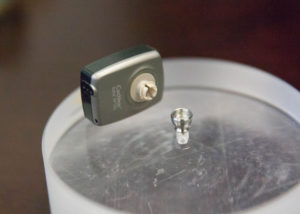
Bone Anchored Hearing Aid (BAHA)
AdHear is a nonsurgical option for adults and older children developed by Medel. An adhesive is used for placement on the skin behind the ear. This is an excellent option for adults and older children who have a conductive hearing loss and do not want surgery.
History And Components

Reports describing a bone anchored hearing device have been found since the 1700’s, and implanted devices such as the BAHA began in 1977. The BAHA became commercially available to the public in 1987 (Information obtained through the International Journal of Health Science, July 2007).
The BAHA has two components: a magnet or abutment which is surgically implanted into the skull and an external sound/speech processor which is worn on the head or ear.
Candidates
Children and adults who suffer from either conductive or mixed hearing loss are candidates for the BAHA device.
How Does It Work?
Sound is collected by the external processor and sent to the internal component which allows the sound to travel naturally through the bone in one’s skull to the cochlea, located within the inner ear. This pathway allows the sound to bypass the parts of the ear which are damaged and resulted in hearing loss.
Management
An evaluation for candidacy is conducted by an audiologist and, if a patient is determined to be a candidate, a BAHA demonstration may be administered the same day to allow one to hear from a BAHA external device. This provides the candidate the ability to experience the BAHA’s benefits. If surgery is desired, an appointment is scheduled with an otolaryngologist to discuss the procedure. Once implanted with a BAHA, adjustments are provided by an audiologist to obtain optimal hearing.










